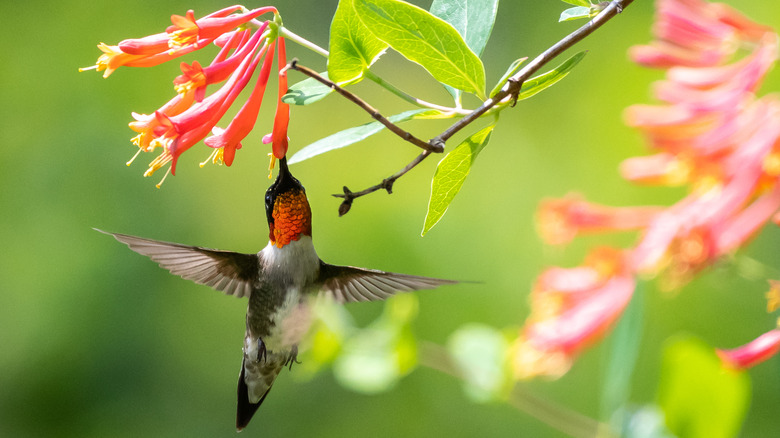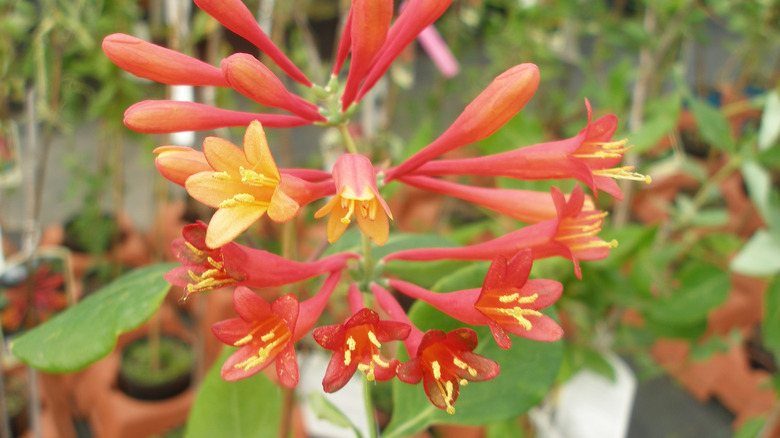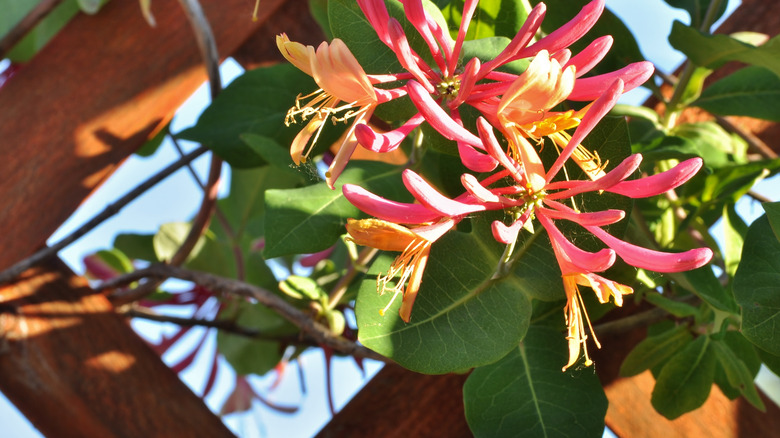Our Master Gardener Says This Easy-To-Grow Plant Makes Lawns A Pollinator Paradise
If you are familiar with the dangers of invasive plants to the ecosystem, you may hear the word "honeysuckle" and automatically assume it's on the "do not plant" list. Thankfully, there is a beautiful native option that attracts beneficial insects and is a favorite of hummingbirds. Coral honeysuckle (Lonicera sempervirens) is a vine that features clusters of trumpet-shaped flowers. Most native cultivars feature red blooms, but some natives range from orange to yellow.
While you probably see Japanese honeysuckle (Lonicera japonica) taking over fields and roadsides, the native version is much less aggressive. It does grow in nature, but unfortunately, the introduction of these invasive vines has allowed them to take over coral honeysuckle's habitat, resulting in fewer benefits to bees, butterflies, and birds. Planting this stunning vine in your garden will not only add beauty, but it will help make your space a much-needed source of food for a wide range of pollinators.
Benefits of coral honeysuckle
Unlike its invasive Japanese cousin, also known as bush honeysuckle, native coral honeysuckle grows as a vine in lengths up to 20 feet. While the blooms of this plant put on an amazing show throughout summer, even the vine itself is an attractive dark orange. In warmer Southern climates, coral honeysuckle is an evergreen, adding color and interest to winter gardens. This gorgeous climber is native and hardy throughout the U.S.
While bees and other pollinators will partake of the nectar and berries provided by Japanese honeysuckle, they much prefer feeding on the native option. Hummingbirds are drawn to their color, while the trumpet-shaped blooms make the nectar within more accessible. This vine also serves as a host plant for the larvae of spring azure and snowberry clearwing moths. At the end of the flowering season, coral honeysuckle produces berries that help feed wild birds throughout the winter.
Growing coral honeysuckle
Perhaps the best thing about coral honeysuckle is that it's an easy climbing plant to grow. You can purchase coral honeysuckle plants at many garden centers or local nurseries, start them from seeds saved from berries, or take softwood cuttings to root. It will take a few years to get a mature plant if you start from seeds, so buying a plant is the fastest way to gain the benefits of this beautiful vine.
Coral honeysuckle is not picky about soil, tolerating conditions from sand to clay. It just needs to be in an area where the soil does not stay too soggy to avoid root rot. Once established, this vine is drought tolerant. A spot in full sun will produce the most blooms, but it will grow and bloom in partial sun conditions. Coral honeysuckle does not require special fertilization, but for the most blooms, adding an inch or two at the base of the plant in the spring may help. Give this amazing vine a trellis to climb on for the most dynamic display, but it also works to hide an ugly fence or to add interest anywhere you want climbing plants.


